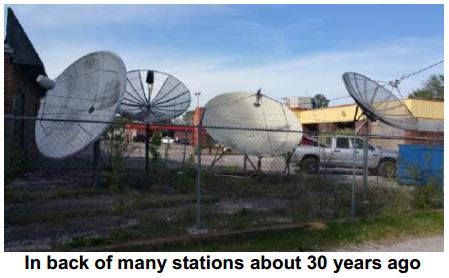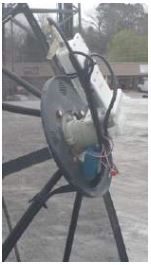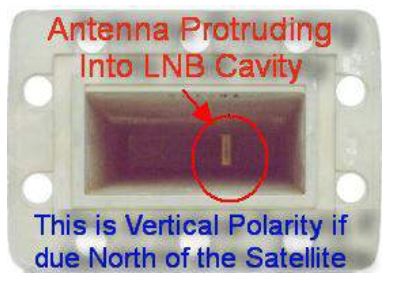The AMC-8 Migration is Under Way

[April 2017] Many stations today get a large part of their daily programming from satellite services. And many of them have been on AMC-8. A major migration is under way, and if you have not planned for this, now is the time to get to it. Kevin Kidd explains.
We knew it would eventually happen. Our multi-decade love/hate relationship with Satcom C5, GE-8, and ultimately AMC-8 is drawing to an end.
AMC-8
AMC-8/GE-8 was launched from Guiana Space Centre or, more commonly, Centre Spatial Guyanais on the East coast of South America in December of 2000.
AMC-8 carries 20 Watt amplifiers with a redundant load of 16 for 12 amplifiers. It also carries redundant receivers at a ratio of 4 for 2. It officially replaced Satcom C5 in the 139 º orbital slot with a design life of 15 years.
But, let us do a little math. Y2K plus 15 equals 2015. Hmmm.
Time Is Up
I am a product of the Tennessee public educational system but the problem is fairly evident.
It is now 2017 and our old friend AMC-8 is getting a little long in the tooth, even if being in pretty good health for her age. There were some power related issues reported in 2006 that limited the total available power for all transponders but, all in all, she has continued to chug along.
Along came November 10, 2016 and the announcement that AMC-8 will not be replaced in the 139º slot and most of the US and regional networks were migrating to AMC-18 over in the 105º orbital slot. (Eventually AMC-18 itself will be replaced in-slot by SES-11 in the 105º slot.)
Many engineers such as myself feared that in today’s cash strapped environment of radio (and especially satellite distributed radio) that we would be returned to the bad old days of the 80’s and 90’s when every station had to have 3 or 4 dishes to receive their daily programming as syndicators each negotiated “better” deals on different satellites.

This thankfully did not come to pass.
Time to Move
As of this writing, we have inspected and moved over a dozen dishes of various sizes and conditions.
A few of these were new to reasonably modern 3.7m dishes in perfect condition. A few were substandard TVRO-type 10-foot mesh dishes on wobbly polar mounts, often not pointed optimally. Most of these were conveniently ground-mounted but some were on the top of two-story buildings.
With some work, all have achieved as good to almost as good EB and AG readings on AMC-18 as on the old satellite. Some even had better numbers but some were worse. Some of these dishes are almost certainly not 100% 2º compliant but most are solid and working for the purpose intended. (All bets are off if new carriers come up later on adjacent birds or cross-polarity transponders.)
The Purpose of This Article
The points laid out below (and in Part II) are not meant to be a primer on satellite dish aiming nor a complete treatise of same.
They are to help you understand what needs to happen in the process of moving an existing dish to receive signals from the new AMC satellite slot.
Truth be told, sometimes a dish re-aim is a real challenge even for those of us with years of experience and the proper test equipment. That is why, if you have never aimed a satellite dish, we strongly recommend getting someone with experience to help. It will make your day go a lot better.
Let me repeat: If you have never aimed a dish, this one probably is not the one to start with unless you have a backup dish that can be left on AMC-8 while you tinker.
No, It Is Not That Big a Deal
If you are an engineer with some satellite experience, your dish and mount are in reasonably good condition, and you have a spectrum analyzer capable of L-band frequencies, it will take you about the same amount of time to re-aim the dish as it does to browse through the following notes and accumulate the information needed.
At the same time, yes, it can be that hard and absolutely maddening when the move does not go well.
If the last two statements give you a slight bit of whiplash, not to worry, this is a chance to learn from my trials and tribulations.
Before You Get Started
Here are some things you need to absolutely, positively know before moving a dish:
1. First and foremost: do not wait until the last minute. June 30th will be here before you know it. And timely deliveries of new dishes will be very problematic in the coming months.
2. Document each and every existing satellite receiver’s EB and AG’s. If bad (Eb worse than 9) try to determine the cause. Then document, document, document everything you see and do.
Pictures of each RX clearly showing the EB/AG and fault lights often are life and face savers. Retake these pictures after the re-aim.
3. Clearly mark or measure all dish adjustments as found in case you need to return it to AMC-8 for some reason.
4. Does this customer have satellite services that have not yet fully-moved their programming onto AMC-18? A number of our regular clients are using Tennessee Radio Network for news and sports programming. As of April 15th, many TRN affiliates were still using Comstream ABR receivers that were not (nor will be) migrated to AMC-18.
Moving a dish with unmigrated services will ruin your day (not to mention that of your customer’s). I understand that there are several other mostly state and small pro-team networks that, as of April 15th, are still awaiting shipment of new receivers.
5. Do you have a clear path to the new satellite? Information on smart phone and on-line augmented reality apps below.
Re-Using a Dish – Or Not
Before moving the dish itself, stop and make sure the dish is going to work reliably. This can require some assistance:
To start off, the dish must be 2º compliant. Most 10-foot dishes may seem to work but, over time, may not work reliably. You may make it work but not reliably. Check to be sure the dish is not too small. A non-2º compliant dish may work fine one day on any given service and not the next due to new services turning on as the move.
Check to be sure the dish is not damaged nor unstable, without interference from adjacent birds – such will present a real challenge.
As you look at the physical structure of the existing dish itself, check to see if has documented specifications that will work at the new location.
If possible, visit the old site a few days before the attempted move to survey the dish and its condition. During that visit, spray all adjustments with a rust-busting penetrate such as PB Blaster. Check all adjustments for potential problems. Then check to ensure:
1. Does the dish have a reasonably modern PLL LNB?
Most providers are specifying 25 kHz or better stability for the XDS streams and even better for some specialized receivers. I moved one with a 500 kHz LNB and somehow it eventually locked – but it took a long time. It has been working like this on AMC-8 for years.
That the station now has a new LNB on order.
2. Can you physically move the dish? What about rusty bolts or actuator? Was it welded (do not laugh, I am replacing a dish that was 100% welded in place) mount to pole, adjustments to mount, dish to mount, and dish to adjustments? In that case, we have to plan to cut it up with a sawzall to move it.
Meanwhile, old TVRO polar-type jack actuators that have not been moved in 20 years are typically frozen solid no matter how much PB Blaster or nitroglycerin you squirt into it.
If the dish has frozen (or welded) hardware or polar jack, you will have to replace that hardware or jack during the move procedure. We have replaced bad polar jacks with everything from carefully drilled solid angle iron to long (typically 20+ inch) turnbuckles and homemade adjusters (welded out of 5/8 ” or larger all-thread), several suitable nuts, and some custom cut angle brackets.
On the other hand, is the mount solid with no play (or flop) in any direction? Many older mounts literally are worn out and are just another factor in a dish being sub-standard. Mounts typically are not worn out from intentional movements but from wind, age and poor design. If the mount is “floppy,” be prepared to stabilize it if the customer cannot – or will not – not purchase a new dish.
As you go, be sure to reiterate your disclaimer on sub-standard dishes. If the dish is substandard according to the satellite provider but I think that it may work (most dishes in this area), I have been advising clients that if they insist, we will move the dish and do our best to aim and peak but if it fails to perform as needed, all time and materials for re-re-re-re-aiming and replacement is billable.
Nevertheless, there have been a couple of dishes that we simply refused to move due to condition or size.
3. To secure a floppy dish, we typically use small galvanized guy wire and turnbuckles to pull the dish back and down to the ground or mounting pole. Be careful not to distort or bend the dish worse than it probably already has been.
4. Make sure you have access to a L-band capable spectrum analyzer (typically up to 3 GHz). If not, in a few hours you will be hating life. I cannot imagine doing it this way, but it can (and many times has been) done by watching the receiver displays, dead reckoning – and a whole lot of patience. A cheap SDR receiver dongle might work fine for an analyzer. I have never tried it but probably will before this ordeal is over.
Before the Actual Move
Here are a few more important points to keep in mind as you prepare for the actual move.
1. amc8migration.com: Check out this excellent migration site hosted by Cumulus.
There you will find most of the info that you need to move dishes with the least pain and suffering. They have Spectrum Analyzer carrier plots and center frequencies for many of the satellite syndicators tabulated there. They also have a little more in-depth tutorial help for locating the new satellite and re-aiming.
2. Carrier Plots. Have the carrier plots handy to help you know when you are on the correct bird.
The plots are on the website mentioned above. I saved a copy of the traces from my first move on my Anritsu MS2721a and can add them as an overlay on the live screen to aid in identifying the new site’s spectrum.
A picture of the plot is almost as good. The areas of the radio service carriers are pretty unique looking and are easily identifiable from the online pictures (considering similar center frequencies, and spans). However, do not assume all the carriers are there 100% of the time.
Have plots of all services available for comparison. Do not believe everything that you see – or do not see.
3. Re-aim Scheduling. Schedule at least (and firmly insist on) a 4-hour window for moving the dish.
Avoid getting into a situation where you are rushed to get it done in a restricted window. Even with a spectrum analyzer our first move (prior to capturing the transponder plots) took a little over 4 hours of frustrated aiming, re-aiming, re-re-aiming, checking receiver status, re-aim, check receiver, re-aim etc.
Understand that the neighborhood of AMC-18 is very congested and at that point in the satellite arc, you can see about 4 satellites simply by swinging the azimuth. This is due to the arc being flattened across the top.
The carrier plots are an essential resource. Our quickest move has been 40 minutes. That is until disaster struck. But more on that 5-hour ordeal later.
The Right Tools to Calculate
You would not try to measure your yard with a 12-inch ruler. Similarly, you need the right tools to set a dish in the right direction.
1. Digital Protractor. If you do not already have one, order a digital protractor from ebay or Amazon.
I have been using a Floureon Axis Level Box Inclinometer Dual-Axis Digital Angle Protractor with 5 Sides Magnetic Base DXL360S that I purchased on Amazon for about $56. It has a user selectable “beep at xx.x angle” function that is really handy for rough elevation setting.
Here in middle Tennessee, the look angle to AMC-18 is 44.75 º. I set my beeper for a 1º window centered on 44.75, slap the little magnetic mounted inclinometer on a verified face square point and start cranking until the little bugger goes into a fit of beeping and we are close.
2. Dish Look Angle Determination. What point on the dish exactly represents the look angle (face angle) of said dish? This can be a good question.
Some dishes have numerous identifiable locations that are square/perpendicular to the face angle while others are all odd angles and rounded surfaces. The angle across the face of the dish is what matters (unless it is an offset feed or multi-sat dish). More on this later…
3. Satellite Center of Box. All tight beam-width satellite dishes should be aimed when the satellite is in the center of its station-keeping box.
Geosynchronous orbit satellites usually stay within an imaginary +/-.1º box in all three orbital axes. Hence, it is best to aim dishes when the bird is in the center of this box. Typically the satellites stay in the published center of box (CoB) for anywhere from 30 minutes to 3 hours per event. For AMC-18, CoB occurs twice per day at roughly (but variable) the same times each day.
Sometimes these CoB events occur at convenient times – and sometimes not. For example, AMC-18’s CoBs for April is about 05:00 (UTC) and 21:00 (UTC). The worst time to aim a dish is when it is at the extremes of the box.
The complete center of box charts for all SES birds.
4. Verify Dish Face Square Points. Know your look angle to the old AMC-8 bird and verify potential face square points for that angle before moving anything.
5. Dish Pointing Apps. There are numerous augmented-reality satellite pointing apps available for both Android and iThings. If would be wise to download and install one or two before getting to the site.
I personally use Android DishPointerPro and a couple different apps both named SatFinder as well as Satbeams Finder. There are a plethora of others.
These apps give you a good indication if you have a path to the new bird. That is if your phone has an accurate compass / inclinometer and is not being interfered with by power or other utility lines.
To check your phone’s accuracy at any time, install a sun position app such as Sun Position Demo to check the sun’s location from your dish’s location. If the sun is not where it is supposed to be, it probably is not the sun’s fault.
6. Additional Dish Aiming Information. There are several websites that offer dish pointing information in various formats.
The sister website to the DishPointerPro app shows the path to selected satellites overlaid on Google Maps. You can preview any potential obstructions as well as potential aim points along the path. I also use lyngsat.com, satbeams.com, and the satellite owner, SES, websites.
AMC-19 Carrier Acquisition
Most of the AMC-8 receivers that we have re-aimed were remotely set up with a fallback receive frequency on AMC-18. This is a mixed blessing.
What happens is the receiver scans back and forth between the old AMC-8 carrier frequency and the new AMC-18 frequency at about four-minute intervals. If you are using a Spectrum Analyzer with the suggested carrier plots then the receiver will eventually scan to the new frequency and lock – or not.
If possible, have a test receiver that can be carried to the back of the dish to monitor EB/NO’s on the new bird/carriers. If you have to remove an active receiver, be very careful to document connector locations and be very careful not to break wires on any connector.
As a contractor doing re-aims for stations that are not my regular clients, I do not remove a connected receiver from a rack unless the stations engineer is present to remove/reinstall. I have a borrowed, spare XDS receiver that I carry for this purpose. The monitor receiver does not have to be permissioned on the station’s services.
Tweaking the Signal In
Once you are sure you see the right satellite, you can tweak the dish components for best signal.
WARNING! Always – Always – Always kill the LNB power before disconnecting, reconnecting, or cutting the coax to the Dish.
A-L-W-A-Y-S!
Here is why: the DC output circuitry on most of these receivers is fairly fragile and will be damaged if the center conductor shorts to anything.
One more time: Save yourself a lot of grief by always killing the LNB power before doing anything to the coax.
Now, let us go on to the adjustments:
1. LNB Mount/Feed. LNB mounts should be mechanically rotatable such that the entire LNB turns to adjust polarity.
Solid TVRO type LNB mounts with the little blue (usually) polar rotator servo may not provide enough cross-polarity rejection for reliable operation even on a good dish.
On many of these feeds, the servo has been discarded such that the polarity can be adjusted by hand but the cross-polarity issue remains.
 These servo movable “hair-pin” type feeds have at least 10 dB (and some have over 30 dB) less cross-polarity rejection than a standard professional type LNB mount. Since smaller and mesh dishes struggle to meet 2° satellite spacing, be aware that you can improve the cross-polarity rejection by replacing a motorized feed with a good fixed feed.
These servo movable “hair-pin” type feeds have at least 10 dB (and some have over 30 dB) less cross-polarity rejection than a standard professional type LNB mount. Since smaller and mesh dishes struggle to meet 2° satellite spacing, be aware that you can improve the cross-polarity rejection by replacing a motorized feed with a good fixed feed.
2. Polarization and Skew. The new signals on AMC-18 are vertically polarized as they were on AMC-8. However, physical LNB orientation is 100% dependent upon the dish’s location relative to the satellite.
Generally, published satellite polarization is relative to the earth’s surface directly under the satellite. What this means is that V only equals V (or H = H) when the satellite is exactly due south of the dish location.
Swinging a properly adjusted polar mount thru the entire arc will keep the polarity skew roughly on track. On the other hand, an AZ/EL mount will require that the skew be set for each and every bird across the arc.
From here in middle Tennessee, the old AMC-8 V-pol was about 48º to the right of vertical due to the skew between our 87º longitude and 139º longitude of AMC-8. The polarity skew from here to AMC-18 is only 23 º to the right.
Dishes physically located between the longitude of AMC-18 (105º) and the longitude of AMC-8 (139º) will see the polarity skew go from leaning right by some amount to leaning left (and no that is not a political statement) by some amount.
Dishes located at longitudes East of 105º will continue to see the polarity skewed to the right by some lesser degree than required for AMC-8.
On common C-band LNB’s, the antenna protrudes into the cavity from the long side of the casting. Hence, vertical is with the LNB in what would appear to be the wrong position.
If you have a question, look up into the feed and you will see the little quarter-wave antenna sticking up (or down).

Turn it until it points straight up or down and that is vertical. Then rotate the LNB to the preliminary location per the skew instructions. The wide dimension of the LNB will be laying horizontal(ish) when the little antenna is vertical.
Turn it until it points straight up or down and that is vertical. Then rotate the LNB to the preliminary location per the skew instructions. The wide dimension of the LNB will be laying horizontal(ish) when the little antenna is vertical.
If the dish does not have a splice behind the dish, you will need to disconnect the coax from the LNB (remember to cut the power supply), or cut the coax at some convenient point near the dish for the insertion of a 2 to 4-way splitter for connecting the Spectrum Analyzer, test receiver, etc.
Also, make sure that you get the power passports connected properly before turning LNB power back on.
Wait – There Is More To Consider
All of the above has been written to show that moving and aligning a dish is not a trivial matter, especially in this case of moving from AMC-8 to AMC-18.
The look angles and elevations are only part of the issue. Do you have a clear view of that part of the sky? Do you have all the information to really identify AMC-18?
And, are you really sure that your old dish is capable of the 2º spacing essential to avoiding interference from adjacent satellite transponders – and adjacent satellites? One thing you surely do not want to do is end up wasting hours of lost programming, and trying to go back to AMC-8.
In Part II we will get down to some of the resources that you will need to collect or have access to as well as some very basic re-aiming procedures – and some Gotcha’s (from experience).
– – –
Kevin C. Kidd, CSRE/AMD, is the proprietor of AM Ground Systems Company and KK Broadcast Engineering.
You can contact Kevin at: kkidd@kkbc.com or via: www.amgroundsystems.com
